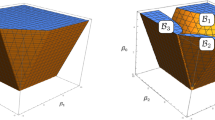Abstract
This paper considers optimal experimental designs for models with correlated observations through a covariance function depending on the magnitude of the responses. This suggests the use of stochastic processes whose covariance structure is a function of the mean. Covariance functions must be positive definite. This fact is nontrivial in this context and constitutes one of the challenges of the present paper. We show that there exists a huge class of functions that, composed with the mean of the process in some way, preserves positive definiteness and can be used for the purposes of modeling and computing optimal designs in more realistic situations. We offer some examples for an easy construction of such covariances and then study the problem of locally D-optimal designs through an illustrative example as well as a real radiation retention model in the human body.




Similar content being viewed by others
References
Amo-Salas M, López-Fidalgo JF, Rodríguez-Díaz JM (2010) Optimizing the test power for a radiation retention model in the human body. Pharm Stat 9:55–66
Amo-Salas M, López-Fidalgo JF, López-Ríos V (2012) Optimal designs for two nested pharmacokinetic models with correlated observations. Commun Stat, Simul Comput 41(7):944–963
Angelis L, Bora-Senta E, Moyssiadis C (2001) Optimal exact experimental designs with correlated errors through a simulated annealing algorithm. Comput Stat Data Anal 37:275–296
Atkinson AC, Donev AN (1992) Optimum experimental designs. Oxford University Press, New York
Berg C, Forst A (1975) Potential theory on locally compact Abelian groups. Ergeb Math Grenzgeb Bd, vol 87. Springer, Berlin
Berg C, Mateu J, Porcu E (2008) The Dagum family of isotropic correlation functions. Bernoulli 14(4):1134–1149
Box GEP, Hill J (1974) Correcting inhomogeneity of variance with power transformation weighting. Technometrics 16(3):385–389
Brimkulov UN, Krug GK, Savanov VL (1986) Design of experiments in investigating random fields and processes. Nauka, Moscow (in Russian)
Dette H, Wong WK (1999) Optimal designs when the variance is a function of the mean. Biometrics 55(3):925–929
Fedorov VV (1972) Theory of optimal experiments. Academic Press, New York
Feller W (1973) An introduction to probability theory and its applications, vol 2. Wiley, New York
Genton MG (2001) Classes of kernels for machine learning: a statistics perspective. J Mach Learn Res 2:299–312
Gneiting T, Schlather M (2004) Stochastic models that separate fractal dimension and the Hurst effect. SIAM Rev 46:269–282
International Commission on Radiological Protection (1994) Human respiratory tract model for radiological protection. ICRP publication, vol 66. Pergamon, Oxford
Jobson JD, Fuller WA (1980) Least squares estimation when the covariance matrix and parameter vector are functionally related. J Am Stat Assoc 75(369):176–181
López-Fidalgo JF, Villarroel J (2007) Optimal designs for models of radiation retention with Poisson correlated response. Stat Med 26(9):1999–2016
López-Fidalgo JF, Wong WK (2002) Design issues for the Michaelis Menten model. J Theor Biol 215(1):1–11
López-Fidalgo JF, Rodríguez-Díaz JM, Sánchez G, Santos-Martín MT (2005) Optimal designs for compartmental models with correlated observations. J Appl Stat 32(10):1075–1088
López-Fidalgo JF, Martin-Martin R, Stehlík M (2008) Marginally restricted D-optimal designs for correlated observations. J Appl Stat 35(6):617–632
Matérn B (1986) Spatial variation, 2nd edn. Springer, Berlin
Müller WG (2007) Collecting spatial data: optimum design of experiments for random fields, 3rd edn. Physica-Verlag, Heidelberg
Müller WG, Stehlík M (2009) Issues in the optimal design of computer simulation experiments. Appl Stoch Models Bus Ind 25:163–177
Pázman A (1986) Foundations of optimum experimental design. Reidel, Dordrecht
Pázman A (2004) Correlated optimum design with a parametrized covariance function. Report no 5, Department of Statistics and Mathematics, Wirtschaftsuniversität Wien, June 2004
Pázman A (2010) Information contained in design points of experiments with correlated observations. Kybernetika 4(6):771–783
Pólya G (1949) Remarks on characteristic functions. In: Proceedings of the Berkeley symposium on mathematical statistics and probability. University of California Press, Berkeley, pp 115–123
Pukelsheim F (1993) Optimal design of experiments. Wiley, New York
Schilling RL, Song R, Vondracek Z (2010) Bernstein functions: theory and applications. de Gruyter, Berlin
Stehlík M, Rodríguez-Díaz JM, Müller WG, López Fidalgo JF (2008) Optimal allocation of bioassays in the case of parametrized covariance functions: an application to lung’s retention of radioactive particles. Test 17:56–68
Ucinski D, Atkinson AC (2004) Experimental design for time-dependent models with correlated observations. Stud Nonlinear Dyn Econom 8(2):13
Ying Z (1993) Maximum likelihood estimation of parameters under a spatial sampling scheme. Ann Stat 21(3):1567–1590
Zastavnyi V, Porcu E (2011) Characterization theorems for the Gneiting class of space-time covariances. Bernoulli 17(1):456–465
Zhu Z, Stein ML (2005) Spatial sampling design for parameter estimation of the covariance function. J Stat Plan Inference 134:583–603
Zhu Z, Zhang H (2006) Spatial sampling design under the infill asymptotic framework. Environmetrics 17:323–337
Acknowledgements
Jesús López-Fidalgo and Mariano Amo-Salas are supported by Ministerio de Economía y Competitividad and Fondos FEDER MTM2010-20774-C03-01 and Junta de Comunidades de Castilla la Mancha PEII10-0291-1850.
Author information
Authors and Affiliations
Corresponding author
Rights and permissions
About this article
Cite this article
Amo-Salas, M., López-Fidalgo, J. & Porcu, E. Optimal designs for some stochastic processes whose covariance is a function of the mean. TEST 22, 159–181 (2013). https://doi.org/10.1007/s11749-012-0311-5
Received:
Accepted:
Published:
Issue Date:
DOI: https://doi.org/10.1007/s11749-012-0311-5
Keywords
- Compartmental Models
- Covariance depending on the mean
- Information matrix
- Locally D-optimal design
- Radiation retention model




